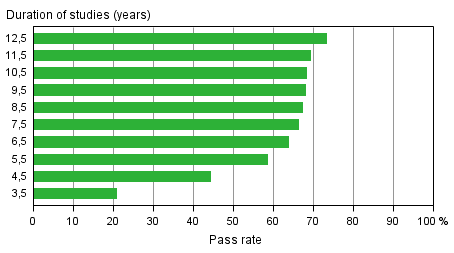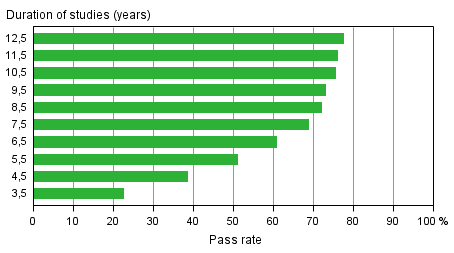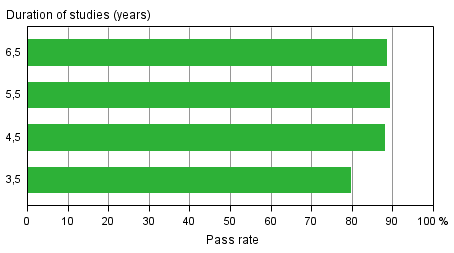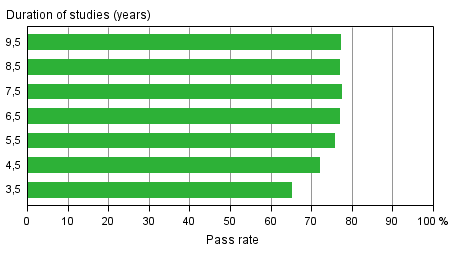Published: 19 March 2015
Polytechnic education was completed faster
According to Statistics Finland's Education Statistics for the year 2013, 80 per cent of upper secondary general school students completed a qualification in at most three-and a-half years. Sixty-five per cent of students attending vocational education aimed at young people passed their qualifications within the same time. Forty-four per cent of students attending polytechnic education aimed at young people completed education in four-and-a-half years. A lower or higher university degree in university education was completed by 51 per cent of students in five-and-a-half years.
Pass rates by sector of education in 2013 and 2012
| Sector of education | Duration of studies (years) | Pass rate 2013 (%) | Pass rate 2012 (%) | Difference between pass rates in 2013–2012 |
| Upper secondary general education aimed at young people | 3,5 | 79,6 | 79,5 | 0,1 |
| Vocational education aimed at young people | 3,5 | 65,1 | 64,3 | 0,8 |
| Polytechnic education (youth education) | 4,5 | 44,3 | 43,3 | 1,0 |
| University education (lower and higher university degrees) | 5,5 | 51,0 | 49,4 | 1,6 |
Pass rates for polytechnic education in different reference periods by the end of 2013

The share of passers of the polytechnic degree in those having started polytechnic education aimed at young people, that is, the pass rate of education, grows the longer time has passed from the start of education. Forty-four per cent of students completed their education in four-and-a-half years or faster. Education was completed in at most seven-and-a-half years by 66 per cent and in twelve-and-a-half years by 73 per cent of polytechnic students.
Pass rates of polytechnic education for young people in 2013 and 2012 by gender for those having studied for 4.5 to 5.5 years
| Sector of education | Duration of studies (years) | Gender | Pass rate 2013 (%) | Pass rate 2012 (%) | Difference between pass rates in 2013–2012 |
| Polytechnic education (youth education) | 4,5 | Men | 29,4 | 28,0 | 1,4 |
| Women | 57,1 | 55,8 | 1,3 | ||
| 5,5 | Men | 46,6 | 43,1 | 3,5 | |
| Women | 68,4 | 67,0 | 1,4 |
Female students in polytechnic education completed their polytechnic degrees more often than men did. Twenty-nine per cent of men and 57 per cent of women passed their polytechnic degree in at most four-and-a-half years, and the difference between the pass rates was 28 percentage points. Fifty-four per cent of men and 72 per cent of women completed education in seven-and-a-half years, that is, the difference between the pass rates was 18 percentage points.
Compared to the situation in 2012, polytechnic degrees were completed in 2013 more often in four-and-a-half years or in five-and-a-half years. The share of those completing their qualification in four-and-a-half years grew for men by 1.4 percentage points and for women by 1.3 percentage points.
One-half of new students in university education completed their degrees in at most five-and-a-half years
Fifty-one per cent of university students completed a higher or lower university degree in at most five-and-a-half years. The older the cohort of new students is examined, the higher the pass rate became: 69 per cent of students completed a higher or lower university degree in at most seven-and-a-half years and as many as 78 per cent of those having studied for 12.5 years had passed a higher or lower university degree.
Pass rates for university education in different reference periods by the end of 2013 (lower and higher university degrees)

As in polytechnic education, there were large differences between sexes in completing university education. Fourty per cent of male students and 59 per cent of female students had completed a higher or lower university degree in five-and-a-half years. The difference between men's and women's pass rates was 19 percentage points.
A higher or lower university degree had been completed in at most seven-and-a-half years by 60 per cent of male students and by 76 per cent of female students, and the difference between the pass rates was thus 16 percentage points. Sixty-nine per cent of male students had completed a higher or lower degree in 12.5 years. For women, the corresponding proportion was 84 per cent, while the difference between the pass rates of sexes was 15 percentage points.
Pass rates of university education in 2013 and 2012 by gender for those having studied for 5.5 to 6.5 years (lower and higher university degrees)
| Sector of education | Duration of studies (years) | Gender | Pass rate 2013 (%) | Pass rate 2012 (%) | Difference between pass rates in 2013–2012 |
| University education (lower and higher university degrees) | 5,5 | Men | 40,2 | 36,9 | 3,3 |
| Women | 59,3 | 58,6 | 0,7 | ||
| 6,5 | Men | 49,4 | 49,6 | -0,2 | |
| Women | 69,0 | 68,8 | 0,2 |
Changes in the pass rates for university education were small between the data for 2012 and for 2013. Only the pass percentage for male students having completed education in at most five-and-a-half years changed by over one percentage point, having grown by around three percentage points.
Women completed upper secondary general school more often than men in four years
According to the data for 2013, upper secondary general education was completed typically in 3.5 to 4.5 years: Eighty per cent of new students in upper secondary general schools completed the upper secondary general school syllabus in at most three-and-a-half years and 88 per cent in at most four-and-a-half years. When the duration of studies was more than four-and-a-half years, the number of completers of upper secondary general education in relation to the number of those starting education settled between 88 and 89 per cent.
Pass rates for upper secondary general education aimed at young people in different reference periods by the end of 2013

Men studying in upper secondary general school passed their qualifications slower than women studying there did. Seventy-nine per cent of men completed their upper secondary general school qualification in three-and-a-half years, while for women, the corresponding figure was 80 per cent.
Pass rates of upper secondary general education aimed at young people in 2013 and 2012 by gender for those having studied for 3.5 to 4.5 years
| Sector of education | Duration of studies (years) | Gender | Pass rate 2013 (%) | Pass rate 2012 (%) | Difference between pass rates in 2013–2012 |
| Upper secondary general education aimed at young people | 3,5 | Men | 78,7 | 78,7 | 0,0 |
| Women | 80,2 | 80,1 | 0,1 | ||
| 4,5 | Men | 86,8 | 88,0 | -1,2 | |
| Women | 88,9 | 88,8 | 0,1 |
Changes in the pass rates for upper secondary general schoo÷ were small between the data for 2012 and for 2013. Only the pass percentage for male students having completed education in at most four-and-a-half years changed by over one percentage point, having reduced by around one percentage point.
Men completed vocational qualifications more often than women in three-and-a-half or four-and-a-half years
The duration of qualifications completed in vocational education for young people varies more than that of upper secondary general qualifications. Sixty-five per cent of vocational education students passed their vocational qualifications in three-and-a-half years or faster. Seventy-two per cent of students completed their education in at most four-and-a-half years.
The pass rate for vocational education grew yearly slightly even for those having studied the longest time: 76 per cent of those having started studies five-and-a-half years earlier and 77 per cent of those having started nine-and-a-half year earlier had completed their qualifications by the end of 2013.
Pass rates for vocational education aimed at young people in different reference periods by the end of 2013

The completion time for vocational education varied between men and women. Sixty-five per cent of male students passed a vocational qualification in three-and-a-half years and 72 per cent in four-and-a-half years. Of female students, 65 per cent completed a vocational qualification in three-and-a-half years and 72 per cent in four-and-a-half years.
Seventy-six per cent of male students passed a vocational qualification in five-and-a-half years Of female students, 75 per cent completed a vocational qualification in five-and-a-half years.
Pass rates of vocational education aimed at young people in 2013 and 2012 by gender for those having studied for 3.5 to 4.5 years
| Sector of education | Duration of studies (years) | Gender | Pass rate 2013 (%) | Pass rate 2012 (%) | Difference between pass rates in 2013–2012 |
| Vocational education aimed at young people | 3,5 | Men | 65,3 | 65,0 | 0,3 |
| Women | 64,8 | 63,5 | 1,3 | ||
| 4,5 | Men | 72,4 | 73,4 | -1,0 | |
| Women | 71,5 | 72,0 | -0,5 |
In particular women completed a qualification in vocational education more often than before in three-and-a-half years instead of four-and-a-half years.
The database tables of these statistics contain information on the differences between the pass rates for different fields of sectors of education (see Tables in databases ). The database tables also include information on those students who did not attain their qualification in the target time.
More information related to the progress of studies is available from statistics describing( Discontinuation of education , Employment of students ).
Source: Education Statistics, Statistics Finland
Inquiries: Mika Witting 029 551 3571, koulutustilastot@stat.fi
Director in charge: Riitta Harala
Publication in pdf-format (270.7 kB)
- Tables
-
Tables in databases
Pick the data you need into tables, view the data as graphs, or download the data for your use.
Appendix tables
- Appendix table 1. Progress of new upper secondary school students (aimed at young people) studies by end 2013 (19.3.2015)
- Appendix table 2. Progress of new students studies in vocational education (aimed at young people) by end 2013 (19.3.2015)
- Appendix table 3. Progress of new polytechnic students studies by end 2013, youth education (19.3.2015)
- Appendix table 4. Progress of new university students studies by end 2013, lower or higher university degrees (19.3.2015)
Updated 19.3.2015
Official Statistics of Finland (OSF):
Progress of studies [e-publication].
ISSN=1799-1021. 2013. Helsinki: Statistics Finland [referred: 20.4.2025].
Access method: http://stat.fi/til/opku/2013/opku_2013_2015-03-19_tie_001_en.html

